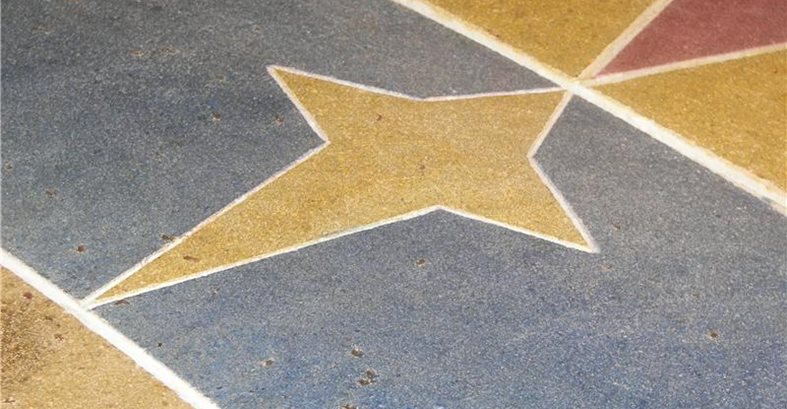- Polished Concrete Information
- Polished Concrete Pictures
- What is Polished Concrete
- Polished Concrete Cost
- Design Ideas for Polished Concrete
- Polished Concrete Maintenance
- Common Questions about Polished Concrete
- Can All Concrete be Polished?
- Comparison Chart: Polished concrete versus other flooring materials
- What are Polished Overlays?
- Polishing Products and Equipment: An overview of basic equipment and supplies needed
- Related Information
- Information About: Concrete Floors
- Concrete Contractors: Find Concrete Polishing Products and Suppliers
- Design Ideas: Polished Concrete Info
Social Hall Floor Gets Eye-Catching Colored Concrete Instead of Boring VCT
Colorful and geometrical floor provides a great look and a theological lessonAt Our Lady of Guadalupe Religious Education Center in Dallas, Ga., the pastor's favorite part of his new building is the social hall floor. When the church's budget called for VCT tiles to cover the concrete floors, parishioner David Severson, owner of Dimensions Concrete Design, knew a better looking floor could be had. "I had to offer up my services," he says, knowing that he could transform the main social hall floor into an inspiring-looking, longer-lasting, and easily maintained surface. "I knew that polishing the concrete would provide a longer-lasting, more durable and slip resistant surface," he says. He submitted a couple of design ideas to the church leaders. "I gave them four different designs," he explains, "a plain colored choice, a fancy diamond inlay pattern, an iconic design, and a theological sunburst." The sunburst pattern was the winning choice that offered more than just something pretty to look at.
Severson's design was carefully thought out to incorporate colors and patterns that represent some of their religious beliefs. The intricate design presented some challenges during the layout process. "We first had to find the center of the room for the main circle," says Severson. "My wife is a mathematician, so I relied on her to figure out the dimensions of the symbol in the middle with concentric half circles. And the whole thing couldn't have been done without my Mongoose saw which cut perfect circles." After the pattern was cut into the concrete, Severson colored the floor with the following intentions:
-
The green concentric circles in the center represent the Trinity.
-
The blue band represents the Virgin Mary.
-
The stars within the blue band represent the 12 stars in the crown as in the book of Revelation.
-
The wheat color of the floor symbolizes the Eucharist.
-
Gold-colored rays extend and connect with 12 pillars that hold up the mezzanine and represent the 12 apostles.
-
Also incorporated were colors of the image of Our Lady of Guadalupe. The rays of gold and red represent light shining or radiating from her.
"In the end, the floor really became a great teaching tool and provides a great theological lesson," says Severson.
The coloring was achieved using Creative Colors dyes and Ameripolish. The blue color was Cobalt by Creative Colors. The red was Raspberry (mixed with Chocolate to darken it). The brown around the edges was Chocolate. The center wheat color was Maize, mixed with a little chocolate to give it an earthy, less yellow color to make it look like bread. The mezzanine (also polished) was colored with Chocolate. And the surrounding classrooms were colored in the wheat color (same as the Eucharist).
The floor was finished using Lavina's SPS Floor Glow penetrating sealer for polished concrete and a lithium densifier from Superabrasive.com. It was highly polished to 3500 grit.
Maintenance with a wet mop is all that the floor requires. "We're resealing it right now with Aquatight," says Severson, "which was developed for granite and marble. It goes on like water with no VOC, no smell. It's not film-forming and gives a high gloss."
Although the end result of the floor is something to marvel at, it didn't come without its own unique challenges during the construction phase. Looking back, Severson says the most challenging part of the project was working with other trades. "I was involved at the beginning of the construction meetings," explains Severson. "I wanted to specify a 4000 mix and a super flat finish to get a good polish, but the contractor didn't know about super flat floors and wanted to do a 3000 mix. We had to compromise at 3500 psi. I urged them not to hand trowel, not to burn it in, not to put any sealers on, and not to cure it," he says. "Unfortunately, they put a cure and seal on it. When I started grinding it was so much harder to cut through," he says. Using two 20-inch Lavina polishing machines, Severson didn't have the super weight to cut through the floor very quickly. "It took five weeks to get it done," he recalls.
Cleaning and masking the floors, moving materials and tools was a constant dance between trades says Severson. For instance, when the knotty pine ceiling was installed, the general contractor planned to spray a polyurethane on it. "I reminded them to cover the floors," says Severson, trying to avoid the foreseeable mess he would have removing the polyurethane film that would form on the floors from the overspray. "Unfortunately, again, they only covered half of the floor at a time, and didn't cover the upper level at all. We lost about a week to removing the film off. There were footprints of polyurethane everywhere," he says.
Lucky for Severson, over 25 years in the business has taught him a thing or two about working with other trades, fixing problems, and overcoming challenges. In the end, what really matters is the glorious polished and colored floor that generations will learn from and enjoy.
Dimensions Concrete Design
Rockmart, GA 30153
Submit Your Own Project Photos
Get inspiring ideas for church floors









